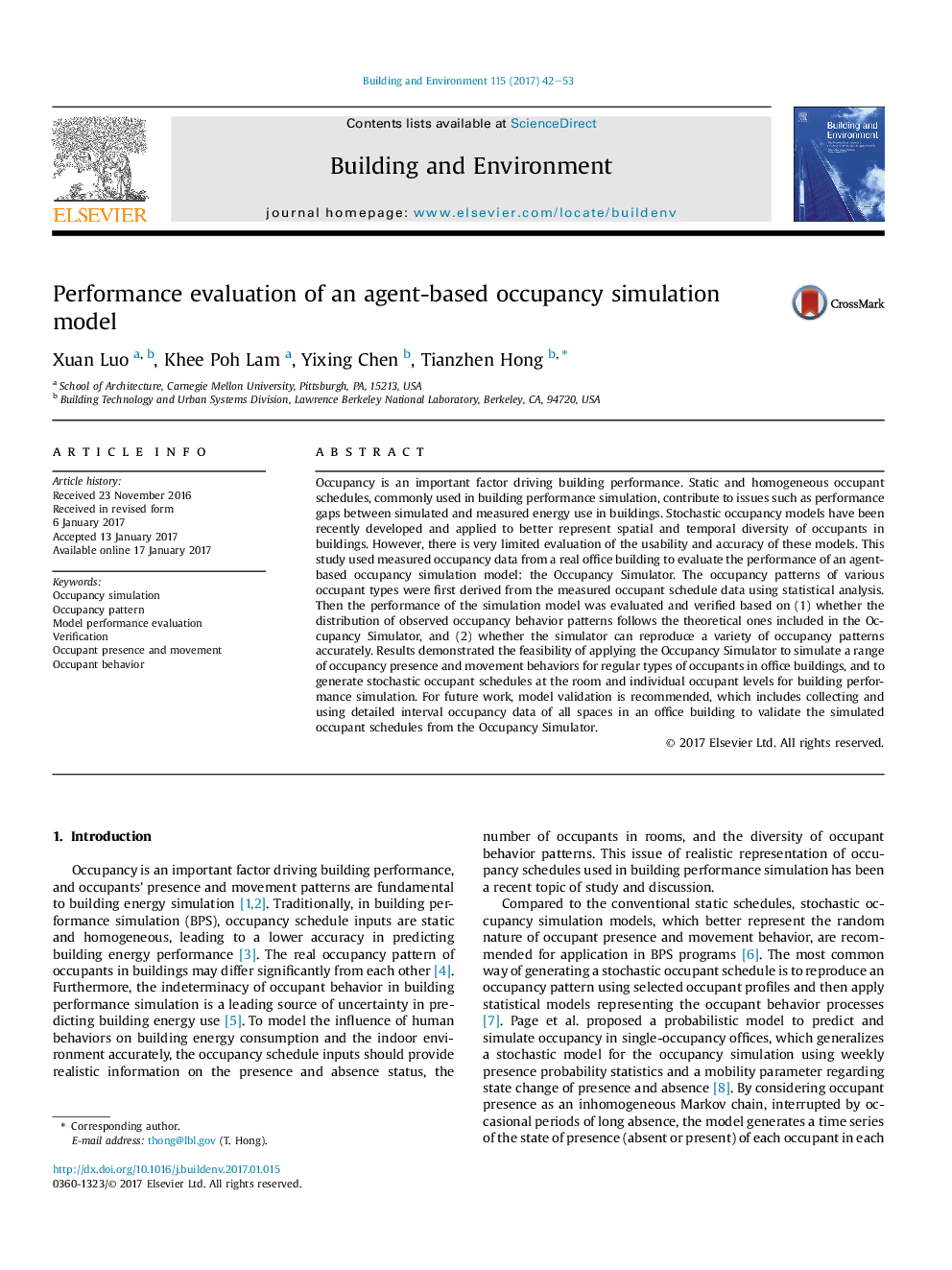| کد مقاله | کد نشریه | سال انتشار | مقاله انگلیسی | نسخه تمام متن |
|---|---|---|---|---|
| 4911532 | 1428377 | 2017 | 12 صفحه PDF | دانلود رایگان |
عنوان انگلیسی مقاله ISI
Performance evaluation of an agent-based occupancy simulation model
ترجمه فارسی عنوان
ارزیابی عملکرد یک مدل شبیه سازی اشغال مبتنی بر عامل
دانلود مقاله + سفارش ترجمه
دانلود مقاله ISI انگلیسی
رایگان برای ایرانیان
کلمات کلیدی
شبیه سازی محل سکونت، الگوی جاذبه، ارزیابی عملکرد مدل، تایید، حضور در محل و حرکت، رفتار شغلی،
ترجمه چکیده
مسکن یکی از عوامل مهم رانندگی ساختمان است. برنامه های ساکن ایستا و همگن، که معمولا در شبیه سازی عملکرد ساختمان استفاده می شود، به مسائلی مانند شکاف عملکرد بین مصرف انرژی شبیه شده و اندازه گیری شده در ساختمان کمک می کند. مدل های اشغال تصادفی اخیرا توسعه داده شده و به کار گرفته شده اند تا بهتر نمایانگر تنوع فضایی و زمانی اشخاص در ساختمان ها باشند. با این حال، ارزیابی بسیار کمی از قابلیت استفاده و دقت این مدل ها وجود دارد. این مطالعه با استفاده از داده های اشغال اندازه گیری از یک ساختمان اداری واقعی برای ارزیابی عملکرد مدل شبیه سازی اشغال مبتنی بر عامل: شبیه ساز اتباع. الگوهای اشغال انواع مختلف ساکنان ابتدا از داده های برنامه ریزی شده اشخاص با استفاده از تحلیل آماری حاصل می شود. سپس عملکرد مدل شبیه سازی بر اساس (1) ارزیابی و تایید شده است که آیا توزیع الگوهای رفتاری مشاهده شده در پی تئوری های موجود در شبیه ساز جاذبه، و (2) آیا شبیه ساز می تواند الگوهای مختلف استخدام را به درستی تولید کند. نتایج نشان داد که امکان استفاده از شبیه ساز جاذبه برای شبیه سازی طیف وسیعی از حضور اشغال و رفتار حرکتی برای انواع منظم مسافران در ساختمان های اداری و ایجاد برنامه های اتفاقی ساکن در اتاق و سطوح فردی برای ایجاد شبیه سازی عملکرد است. برای کار آینده، اعتبار سنجی مدل توصیه می شود، که شامل جمع آوری و استفاده از داده های مربوط به ذخیره سازی تمام فواصل در ساختمان اداری برای تایید برنامه های شبیه سازی شده ساکن از شبیه ساز جاذبه است.
موضوعات مرتبط
مهندسی و علوم پایه
مهندسی انرژی
انرژی های تجدید پذیر، توسعه پایدار و محیط زیست
چکیده انگلیسی
Occupancy is an important factor driving building performance. Static and homogeneous occupant schedules, commonly used in building performance simulation, contribute to issues such as performance gaps between simulated and measured energy use in buildings. Stochastic occupancy models have been recently developed and applied to better represent spatial and temporal diversity of occupants in buildings. However, there is very limited evaluation of the usability and accuracy of these models. This study used measured occupancy data from a real office building to evaluate the performance of an agent-based occupancy simulation model: the Occupancy Simulator. The occupancy patterns of various occupant types were first derived from the measured occupant schedule data using statistical analysis. Then the performance of the simulation model was evaluated and verified based on (1) whether the distribution of observed occupancy behavior patterns follows the theoretical ones included in the Occupancy Simulator, and (2) whether the simulator can reproduce a variety of occupancy patterns accurately. Results demonstrated the feasibility of applying the Occupancy Simulator to simulate a range of occupancy presence and movement behaviors for regular types of occupants in office buildings, and to generate stochastic occupant schedules at the room and individual occupant levels for building performance simulation. For future work, model validation is recommended, which includes collecting and using detailed interval occupancy data of all spaces in an office building to validate the simulated occupant schedules from the Occupancy Simulator.
ناشر
Database: Elsevier - ScienceDirect (ساینس دایرکت)
Journal: Building and Environment - Volume 115, April 2017, Pages 42-53
Journal: Building and Environment - Volume 115, April 2017, Pages 42-53
نویسندگان
Xuan Luo, Khee Poh Lam, Yixing Chen, Tianzhen Hong,
